9 October 2013
Mass Games: The greatest show in North Korea?
By Clarissa Sebag-Montefiore
-

-
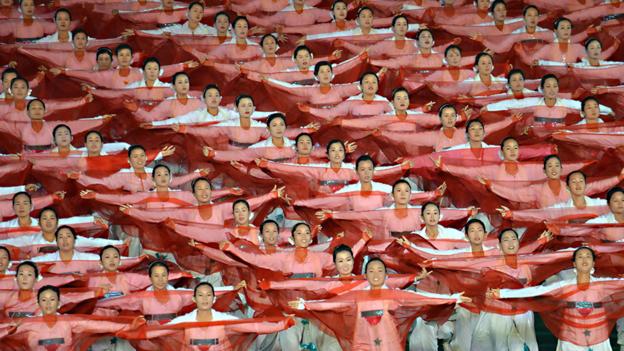
-
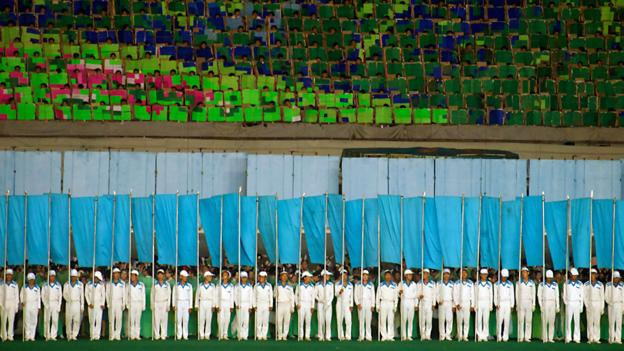
-
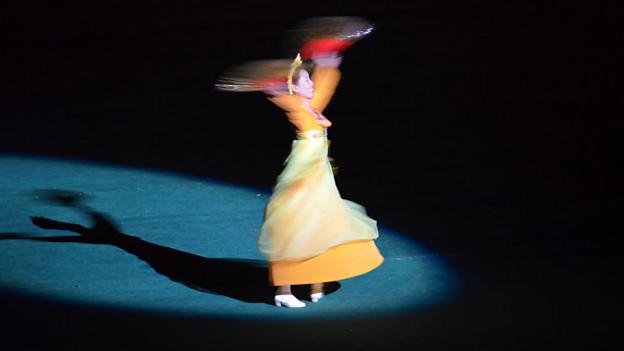
-
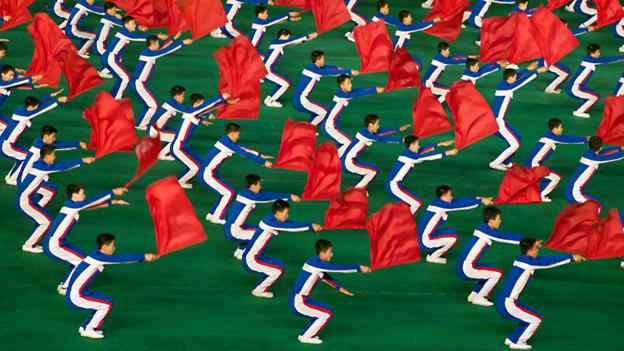
-
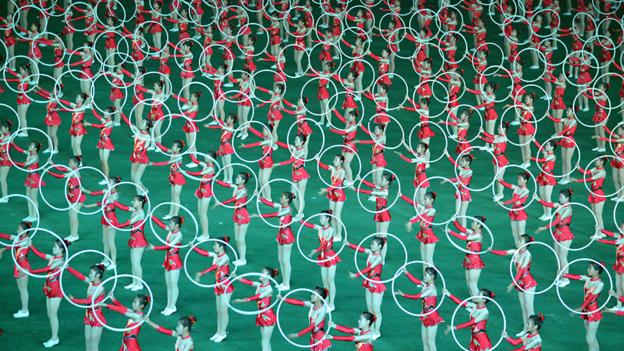
-
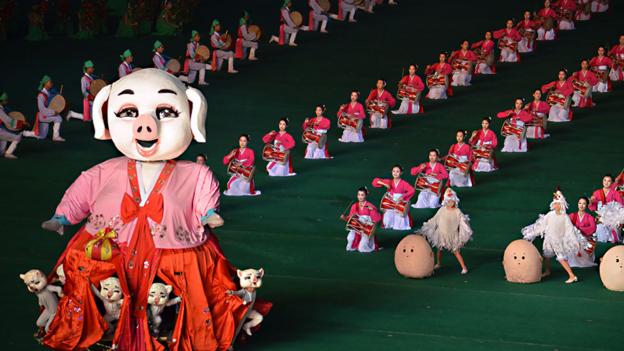
-
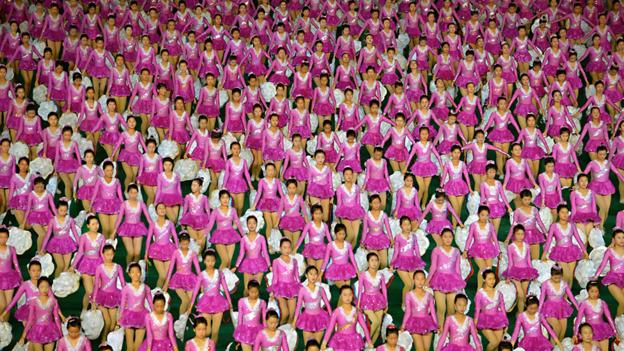
-
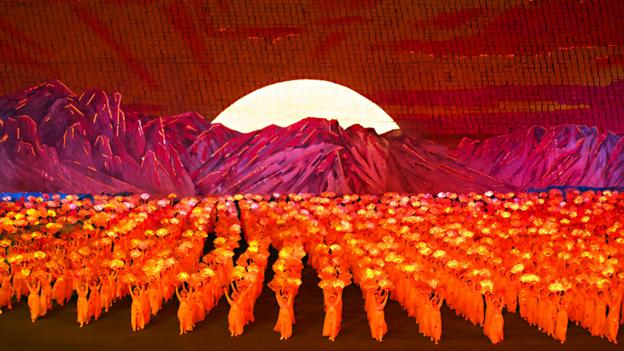
HIDE CAPTION
- Political stage
-
North Korea’s Mass Games are a theatrical spectacle of music, dance,
gymnastics and pyrotechnics that aim to demonstrate the state’s power.
(All photos: Clarissa Sebag-Montefiore)
North Korea’s Mass Games is an annual spectacle that combines sumptuous
theatricality with state worship. It’s Cirque du Soleil on steroids,
writes Clarissa Sebag-Montefiore.
One
hundred thousand participants are about to perform in the only show of
its kind on earth. In the shadow of the gargantuan May Day Stadium in
Pyongyang, children in pink ballet leotards chatter excitedly. Four
soldiers pose together for a photograph and a platoon of pretty girls in
military uniform (their short skirts worn above black knee-high boots)
march in unison across the car park. The Mass Games is on and there is a
palpable excitement in the air.
The Games is a state propaganda
extravaganza that showcases the nation’s brawn through 90 minutes of
rousing music and mesmerising dance and gymnastics. It is watched by
tens of thousands of audience members – many of whom are shipped in from
the countryside by their communist work units – in the highest capacity
seating stadium in the world.
What is most striking is the Games’
sumptuous theatricality – like Cirque du Soleil on steroids. As in the
famous Quebec-based circus, much of the Mass Games is made up of
performers doing superhuman acrobatic feats in glittering garments.
Unlike Cirque du Soleil many of them are children. The Mass Games is
also bigger, bolder, and utilitarian. Like China’s 2008 Olympic opening
ceremony it expertly fuses politics and spectacle. But it is more than
simply a display of power at home and abroad: for North Koreans the Mass
Games is a chance to exhibit the arts, whether music, dance, or
theatre. Woven into it all is a storyline of the revolutionary struggle.
The years of hardship under Japanese colonialism are portrayed in
stirring, soulful melodies and tableaux of heartrending torment. In one
scene thousands of swaying silver trees (made up of people in costume)
glinted in a snowy storm. In another, desperate refugees flee from the
Japanese. Lightning explodes, their chains implode and in the sky a star
ascends. It ushers in the birth in 1912 of Kim Il Sung, who was
declared North Korea’s eternal president after his death. Deified, he
becomes the sun itself, beaming benevolently over the stadium.
Performed
annually from August to October, this is a perfectly synchronised orgy
of state worship that requires the total sacrifice of the individual for
the group. More than a million man-hours are required to assemble the
Games to foster the socialist values of team work, order, and obedience.
In 1987 Kim Jong Il declared that mass gymnastics creates “healthy and
strong physiques, a high degree of organisation, discipline and
collectivism in schoolchildren… [They] make every effort to subordinate
all their thoughts and actions to the collective.”
Since 2002 the
Mass Games has been based on Arirang, a Korean folk story akin to Romeo
and Juliet. It is a plot of lovers torn asunder by external forces and
is emblematic of the division of the Korean peninsula following the
brutal Korean War. “The Mass Games is based on a century long desire of
reunifying our country,” my North Korean guide tells me. “The main point
of the Mass Games is the division of the nation. This is a very sad
tragedy.”
Wave forms
Tragedy, however,
seems to be the last thing on the minds of the 20,000 school children
that make up one entire side of the stadium. By flipping simultaneously
through 150 pages of prepared books they create an ever-changing mosaic
of images. These form a vast story-high backdrop to the performance. As
we wait for the Games to begin, the children let rip. Every vertical
column is made up of a different school. In turn they propel their pages
furiously while expelling a unified roar, each group vying to be louder
than the next. It creates a deafening human wave of noise.
Images
and film clips of the Mass Games often appear digitised in the vein of a
Lord of the Rings battle. On screen, the colossal human formations seem
too Herculean, too perfect, to be real. Nothing, then, prepared me for
the sheer scale of manpower on display when the Games commenced.
Most
awe-inspiring are demonstrations of the nation’s militant strength. It
is not just goose-stepping: last year’s satellite launch, for example,
is replayed on a giant screen. The night can also veer into the tacky
and kitsch. In one act towering pink pigs totter on stage, giving birth
to piglets that run out from underneath their billowing skirts, where
they pirouette alongside dancing eggs. This bizarre sequence represents
agricultural abundance and bucolic bliss. The famine, in which countless
tens of thousands perished in the 1990s, is ignored.
Stadium of light
Later
aerial gymnasts swing high above us; supple bodies twist and turn in a
ballet in the sky before dropping, tornado-like into invisible nets. Lit
by spotlights in an otherwise pitch-black stadium they remind me of
fireflies. Such dazzling moments make me forget at times that the Mass
Games is essentially the product of a totalitarian state flexing its
muscle and might under the guise of entertainment.
Lest that be
overlooked, there are always the flashing background images that
relentlessly besiege the audience. These may be shepherded by children,
but the pictures range from the seemingly banal to the frightening. One
shows a new housing area in Pyongyang that was launched by Kim Jong Il;
another a cartoon of a boy scoring a goal; yet another two giant
pistols. Portraits of a grinning Kim Il Sung and Kim Jong Il also flash
up – for these the children must hunch together so as not to leave any
cracks −which are seen as disrespectful − in the leaders’ faces.
Critics
of the Mass Games have compared it to the Nuremberg Rallies of the
Third Reich, for the cult of personality and ultra-nationalism on
display. They have also pointed to the use of children in the games,
some of whom are as young as five or six. “It is not a society where you
say no. As a group you do it,” explains Nick Bonner, founder of Koryo
Tours, who I travelled with to North Korea.
Bonner followed two
teenage gymnasts for eight months for the groundbreaking documentary A
State of Mind, as they prepared to perform in the 2003 Mass Games. The
film expertly shows how a people are indoctrinated into believing the
state’s ideology. In A State of Mind the girls, aged 11 and 13, train
outdoors on concrete floors in temperatures below zero. Their schedule
intensifies in the months leading up to the Games, rising from three
hours a day to up to eight. Driving them is the belief they might
perform in front of General Kim Il Jong, a man they see as a father to
the nation. Loss of face is another factor: if one person does not make
the grade the entire group will be cut from the performance. “There is
no question that it requires a 110 percent effort and obedience. It’s
normal for kids that age, it is part of their fabric,” says Bonner.
The
Games ends in a profusion of fireworks and a nod towards friendships
with China and Russia, the latter country introduced for the first time
this year and represented by dancing Russian bears. The grand finale is a
salute to world peace: a globe sits centre stage, North Korea
highlighted in red. Tens of thousands of performers flood the arena –
filling it from corner to corner with practiced precision and waving
their arms ecstatically in unison while grasping giant Kimjongilias (a
vivid vermillion-coloured flower named after Kim Jong Il). It is a
reminder of the country’s dedication to the use of both pageant and
performing arts for political ends. In the tour bus on the way back to
the hotel I talk to a young, fiery guide. Now in his mid twenties he
looks back with a smile on the year he danced in the Mass Games a decade
ago. The eight months of training was tough, sometimes dull. But, he
said, it was worth it. “For us the most important, precious thing is to
give pleasure to our leaders.”
North
Korea’s Mass Games is an annual spectacle that combines sumptuous
theatricality with state worship. It’s Cirque du Soleil on steroids,
writes Clarissa Sebag-Montefiore.
http://www.bbc.com/culture/
Mass Games: The greatest show in North Korea?
By Clarissa Sebag-Montefiore
HIDE CAPTION
- Political stage
- North Korea’s Mass Games are a theatrical spectacle of music, dance, gymnastics and pyrotechnics that aim to demonstrate the state’s power. (All photos: Clarissa Sebag-Montefiore)
North Korea’s Mass Games is an annual spectacle that combines sumptuous
theatricality with state worship. It’s Cirque du Soleil on steroids,
writes Clarissa Sebag-Montefiore.
One
hundred thousand participants are about to perform in the only show of
its kind on earth. In the shadow of the gargantuan May Day Stadium in
Pyongyang, children in pink ballet leotards chatter excitedly. Four
soldiers pose together for a photograph and a platoon of pretty girls in
military uniform (their short skirts worn above black knee-high boots)
march in unison across the car park. The Mass Games is on and there is a
palpable excitement in the air.The Games is a state propaganda extravaganza that showcases the nation’s brawn through 90 minutes of rousing music and mesmerising dance and gymnastics. It is watched by tens of thousands of audience members – many of whom are shipped in from the countryside by their communist work units – in the highest capacity seating stadium in the world.
What is most striking is the Games’ sumptuous theatricality – like Cirque du Soleil on steroids. As in the famous Quebec-based circus, much of the Mass Games is made up of performers doing superhuman acrobatic feats in glittering garments. Unlike Cirque du Soleil many of them are children. The Mass Games is also bigger, bolder, and utilitarian. Like China’s 2008 Olympic opening ceremony it expertly fuses politics and spectacle. But it is more than simply a display of power at home and abroad: for North Koreans the Mass Games is a chance to exhibit the arts, whether music, dance, or theatre. Woven into it all is a storyline of the revolutionary struggle. The years of hardship under Japanese colonialism are portrayed in stirring, soulful melodies and tableaux of heartrending torment. In one scene thousands of swaying silver trees (made up of people in costume) glinted in a snowy storm. In another, desperate refugees flee from the Japanese. Lightning explodes, their chains implode and in the sky a star ascends. It ushers in the birth in 1912 of Kim Il Sung, who was declared North Korea’s eternal president after his death. Deified, he becomes the sun itself, beaming benevolently over the stadium.
Performed annually from August to October, this is a perfectly synchronised orgy of state worship that requires the total sacrifice of the individual for the group. More than a million man-hours are required to assemble the Games to foster the socialist values of team work, order, and obedience. In 1987 Kim Jong Il declared that mass gymnastics creates “healthy and strong physiques, a high degree of organisation, discipline and collectivism in schoolchildren… [They] make every effort to subordinate all their thoughts and actions to the collective.”
Since 2002 the Mass Games has been based on Arirang, a Korean folk story akin to Romeo and Juliet. It is a plot of lovers torn asunder by external forces and is emblematic of the division of the Korean peninsula following the brutal Korean War. “The Mass Games is based on a century long desire of reunifying our country,” my North Korean guide tells me. “The main point of the Mass Games is the division of the nation. This is a very sad tragedy.”
Wave forms
Tragedy, however, seems to be the last thing on the minds of the 20,000 school children that make up one entire side of the stadium. By flipping simultaneously through 150 pages of prepared books they create an ever-changing mosaic of images. These form a vast story-high backdrop to the performance. As we wait for the Games to begin, the children let rip. Every vertical column is made up of a different school. In turn they propel their pages furiously while expelling a unified roar, each group vying to be louder than the next. It creates a deafening human wave of noise.
Images and film clips of the Mass Games often appear digitised in the vein of a Lord of the Rings battle. On screen, the colossal human formations seem too Herculean, too perfect, to be real. Nothing, then, prepared me for the sheer scale of manpower on display when the Games commenced.
Most awe-inspiring are demonstrations of the nation’s militant strength. It is not just goose-stepping: last year’s satellite launch, for example, is replayed on a giant screen. The night can also veer into the tacky and kitsch. In one act towering pink pigs totter on stage, giving birth to piglets that run out from underneath their billowing skirts, where they pirouette alongside dancing eggs. This bizarre sequence represents agricultural abundance and bucolic bliss. The famine, in which countless tens of thousands perished in the 1990s, is ignored.
Stadium of light
Later aerial gymnasts swing high above us; supple bodies twist and turn in a ballet in the sky before dropping, tornado-like into invisible nets. Lit by spotlights in an otherwise pitch-black stadium they remind me of fireflies. Such dazzling moments make me forget at times that the Mass Games is essentially the product of a totalitarian state flexing its muscle and might under the guise of entertainment.
Lest that be overlooked, there are always the flashing background images that relentlessly besiege the audience. These may be shepherded by children, but the pictures range from the seemingly banal to the frightening. One shows a new housing area in Pyongyang that was launched by Kim Jong Il; another a cartoon of a boy scoring a goal; yet another two giant pistols. Portraits of a grinning Kim Il Sung and Kim Jong Il also flash up – for these the children must hunch together so as not to leave any cracks −which are seen as disrespectful − in the leaders’ faces.
Critics of the Mass Games have compared it to the Nuremberg Rallies of the Third Reich, for the cult of personality and ultra-nationalism on display. They have also pointed to the use of children in the games, some of whom are as young as five or six. “It is not a society where you say no. As a group you do it,” explains Nick Bonner, founder of Koryo Tours, who I travelled with to North Korea.
Bonner followed two teenage gymnasts for eight months for the groundbreaking documentary A State of Mind, as they prepared to perform in the 2003 Mass Games. The film expertly shows how a people are indoctrinated into believing the state’s ideology. In A State of Mind the girls, aged 11 and 13, train outdoors on concrete floors in temperatures below zero. Their schedule intensifies in the months leading up to the Games, rising from three hours a day to up to eight. Driving them is the belief they might perform in front of General Kim Il Jong, a man they see as a father to the nation. Loss of face is another factor: if one person does not make the grade the entire group will be cut from the performance. “There is no question that it requires a 110 percent effort and obedience. It’s normal for kids that age, it is part of their fabric,” says Bonner.
The Games ends in a profusion of fireworks and a nod towards friendships with China and Russia, the latter country introduced for the first time this year and represented by dancing Russian bears. The grand finale is a salute to world peace: a globe sits centre stage, North Korea highlighted in red. Tens of thousands of performers flood the arena – filling it from corner to corner with practiced precision and waving their arms ecstatically in unison while grasping giant Kimjongilias (a vivid vermillion-coloured flower named after Kim Jong Il). It is a reminder of the country’s dedication to the use of both pageant and performing arts for political ends. In the tour bus on the way back to the hotel I talk to a young, fiery guide. Now in his mid twenties he looks back with a smile on the year he danced in the Mass Games a decade ago. The eight months of training was tough, sometimes dull. But, he said, it was worth it. “For us the most important, precious thing is to give pleasure to our leaders.”
http://www.bbc.com/culture/










沒有留言:
張貼留言